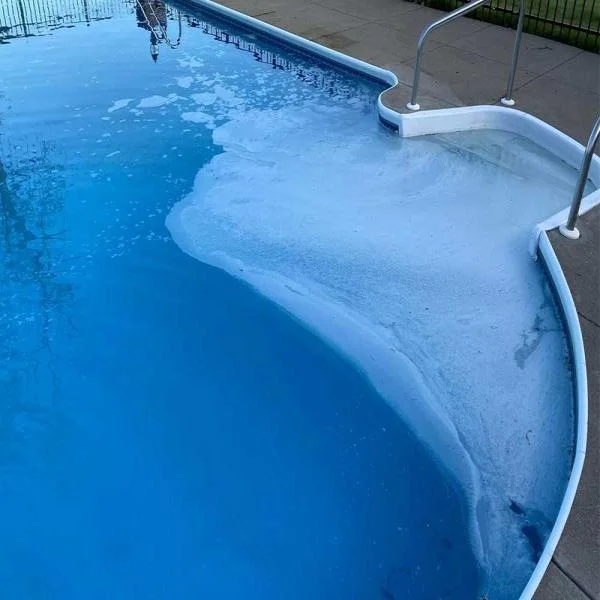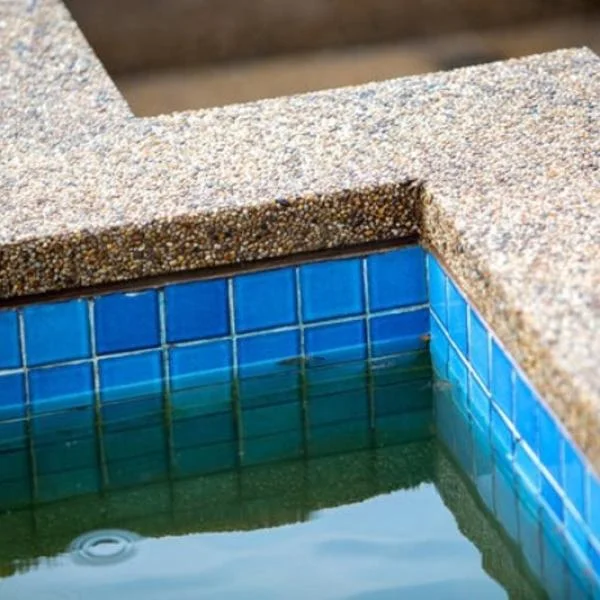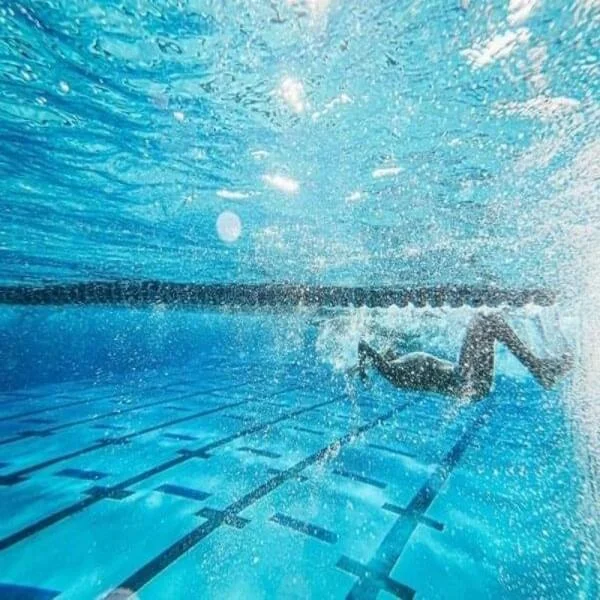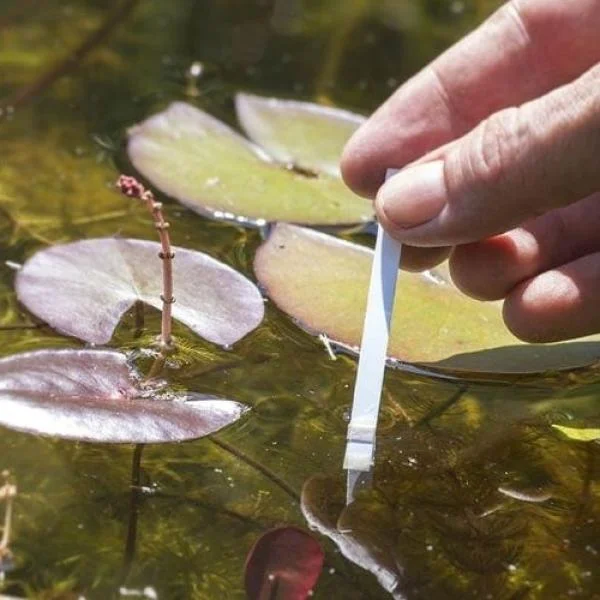
Maintaining the correct pool water pH level is crucial for the safety of swimmers, the longevity of pool equipment, and the clarity of the water. If a pool water's pH is too high or too low, it can cause a range of issues that could affect your enjoyment of the pool and increase maintenance costs. In this article, we will explain why pool water pH matters, how to test it and provide steps to maintain the proper pH balance.
What is Pool Water pH?
The term "pH" refers to the level of acidity or alkalinity in a substance, and in the case of pool water, it measures the balance between the acidic and basic elements present. The pH scale has a range of 0 to 14, with 7 being neutral. A pH lower than 7 is acidic and above 7 is basic (or alkaline). Ideally, pool water pH should have a level between 7.2 and 7.8. This range is the pH which makes it comfortable for swimmers while also helping pool chemicals, such as chlorine, function properly.
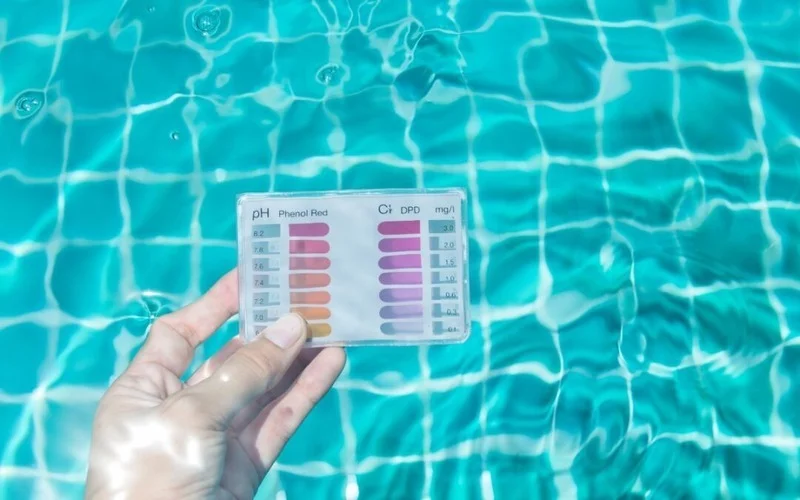
If the pH level of pool water is outside this range, it can lead to several problems for the water damaging pool liners and corroding equipment.
Why Pool Water pH is Important
Maintaining the ideal pool water pH level is crucial for several reasons. Firstly, it ensures swimmer comfort. A balanced pH (between 7.2 and 7.8) prevents skin irritation, red eyes, and respiratory issues arising from water being too acidic or alkaline. Secondly, it maximizes chemical effectiveness, particularly chlorine, which works best when the pH is within this range. If the pH is too high, chlorine becomes less efficient at killing bacteria and algae, while a too-low pH can cause over-sanitization, irritating swimmers and damaging equipment. Thirdly, maintaining the correct pH helps prevent algae growth. When pH levels are too high, chlorine’s reduced efficiency allows algae to thrive, leading to green or cloudy water.
Additionally, proper pH levels protect pool equipment. Acidic water corrodes metal parts and damages surfaces, while alkaline water can cause calcium scaling, which clogs filters and reduces equipment performance. Lastly, balanced pH levels contribute to water clarity. High pH often results in cloudy, unattractive water, signaling potential issues with water chemistry and sanitation. Keeping the pH balanced, you ensure your pool remains clear, safe, and attractive.
How to Test Pool Water pH
Testing the pool water pH level is a simple process, and it should be done regularly to ensure the water is balanced. Here are a few methods for testing pool pH:
Test Strips
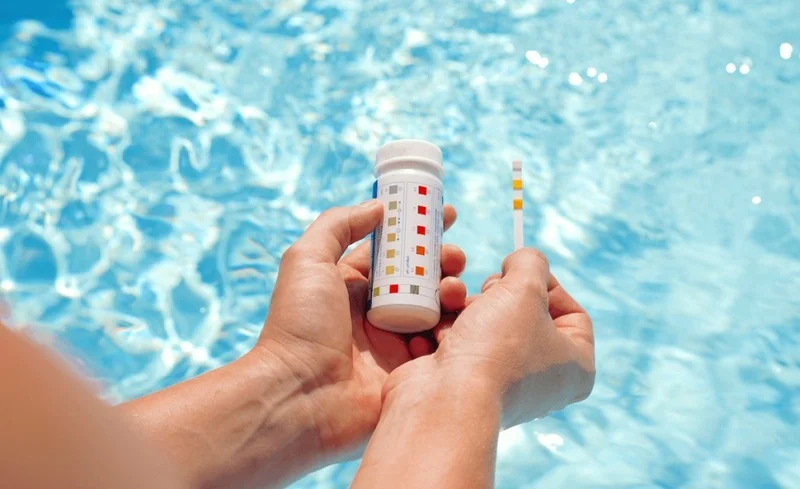
Test strips are the most common option for measuring pH levels. Dip a test strip into the pool water and compare the color on the strip to the corresponding chart on the test kit. The chart will indicate the pH level based on the color change, making it easy to determine if adjustments are necessary.
Liquid Test Kits
Liquid test kits provide a more accurate way to measure pH than test strips. With these kits, you will add pool water to a test tube, mix it with a liquid reagent, and compare the color change to a pH scale.
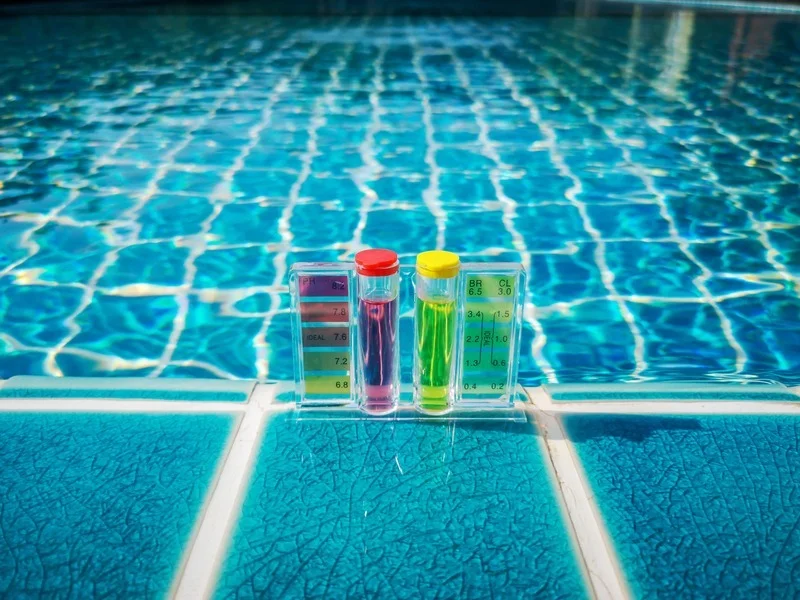
Digital pH Meters
Use a digital pH meter for the most accurate measurement. Although digital meters are more expensive, they are ideal for pool owners who want to maintain precise control over their water chemistry.
How to Adjust Pool Water pH
After testing your pool's pH, you may need to adjustments to bring it within the ideal range of 7.2 to 7.8. Here's how to lower or raise the pH, depending on the results of your test:
Lowering pH
If the pool water pH is too high, you’ll need to add an acid to bring it down to the desired level. The two most common products used to lower pH are muriatic acid and sodium bisulfate. Both are effective, but muriatic acid tends to work faster, while sodium bisulfate is safer to handle.
Steps to Lower pH:
- Determine the pH level of the water by testing it.
- Calculate the amount of acid required using the product's instructions.
- Dilute the acid in a bucket of pool water (following safety instructions).
- Pour the diluted solution evenly around the pool, avoiding metal or concrete surfaces.
- Allow the pool water to circulate for at least 4 to 6 hours.
- Retest the pH to ensure it’s within the target range.
Raising pH
If the pool’s pH is too low, adding an alkaline substance, such as sodium carbonate (also known as soda ash), will help increase it. This substance is effective at raising both pH and alkalinity levels.
Steps to Raise pH:
- Test the water to determine the current pH level.
- Calculate the required amount of soda ash using the product instructions.
- Pre-dissolve the soda ash in a bucket of pool water (optional for better distribution).
- Slowly pour the solution around the pool's edges while the pump is running.
- Let the water run for a few hours.
- If necessary, restart the pH test and make any additional adjustments.
Tips for Preserving pH Level Balance
After adjusting a pool water pH, regular maintenance is necessary to keep it within the proper range. Here are some tips to help maintain balanced pH levels:
- Test regular pool pH levels at least 2-3 times weekly, especially during the peak swimming season to ensure that can catch early any significant issues.
- Monitor rainfall and pool use frequently can affect your water’s pH. Rainwater is naturally acidic, which can lower your pool’s pH. Similarly, a high number of swimmers can introduce contaminants and disrupt the pH balance.
- Check alkalinity to the pool's alkalinity (between 80-120 ppm) to stabilize pH. Alkalinity acts as a buffer for pH, helping to prevent sudden shifts. If your pool's alkalinity is too low, it can cause pH levels to fluctuate rapidly.
- Clean pool filters regularly will help maintain proper water flow and chemical distribution. A clogged filter can reduce water circulation and cause chemical imbalances, including pH fluctuations.
- Avoid pool over-shocking because can raise pool water pH. Follow the manufacturer’s guidelines and avoid adding more shock than necessary.
Where to Buy Quality pH Adjusting Chemicals for Pool Water
Dong A Chemical is a leading factory in Vietnam that specializes in providing water treatment chemicals for swimming pools. Dong A ensures that all water treatment chemical products meet high-quality standards have clear origins and are a reliable address for a large number of customers. In addition, Dong A provides the best prices on the market for purchases made.

Hopefully, with the information in this article, you know why pool water pH matters. If you need to buy a product, please immediately contact us at hotline (+84) 985797941 for advice and the best price.
Related Articles
Why Is Foam in Pool Water? Causes and Solutions
Contaminants create foam in pool water and tend to stick around, causing your pool an unattractive, ...
Why Does Change Pool Water Color? Common Reasons Explained
A pool water color blue pool is every pool owner’s dream. However, maintaining that crystal-clear ...
How to Clean Pool Tiles: Remove Calcium Deposition, Stains, and Algae
Keeping clean pool tiles is essential for maintaining your swimming pool's appearance and ...
Everything About Ozone Pool Systems Need to Know
Ozone plays an important role in protecting us from the sun, but did you know it can also protect ...
Understanding Dissolved Oxygen: A Vital Component of Aquatic Ecosystems
Dissolved oxygen (DO) is a crucial element in aquatic ecosystems, playing a fundamental role in ...
pH in Ponds: Maintaining a Healthy Aquatic Ecosystem
When it comes to maintaining a thriving pond ecosystem, one of the most critical factors to consider ...

